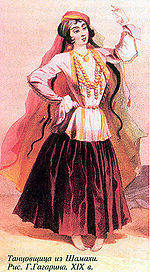| Revision as of 20:14, 31 July 2023 view source2a02:aa1:1626:cadd:f5ba:c858:1a4c:ce24 (talk) You haven’t explained anythingTags: Reverted Mobile edit Mobile web edit← Previous edit | Revision as of 12:12, 2 August 2023 view source KhndzorUtogh (talk | contribs)Extended confirmed users1,935 edits disruptive IP changeTags: Undo RevertedNext edit → | ||
| Line 1: | Line 1: | ||
| {{short description|Traditional dress of the peoples of the Caucasus and Iran}} | {{short description|Traditional dress of the peoples of the Caucasus and Iran}} | ||
| ] wearing an arkhalig]] | ] wearing an arkhalig]] | ||
| An '''arkhalig''' ({{lang-hy|արխալուղ}}, {{lang-az|arxalıq}}, {{lang-ka|ახალუხი}},{{lang-fa|ارخالق}}) is part of both male and female traditional dress of the ] and ]. The arkhalig originated from the ''beshmet'', a ] outer clothing later worn by ]s.<ref> {{webarchive |url=https://web.archive.org/web/20070927235101/http://www.yuga.ru/kazaki/history/index.shtml?id=4404 |date=September 27, 2007 }} by S.Ivanov</ref> | An '''arkhalig''' ({{lang-hy|արխալուղ}}, {{lang-az|arxalıq}}, {{lang-ka|ახალუხი}},{{lang-fa|ارخالق}}) is part of both male and female traditional dress of the ] and ]. The arkhalig originated from the ''beshmet'', a ] outer clothing later worn by ]s.<ref> {{webarchive |url=https://web.archive.org/web/20070927235101/http://www.yuga.ru/kazaki/history/index.shtml?id=4404 |date=September 27, 2007 }} by S.Ivanov</ref> | ||
Revision as of 12:12, 2 August 2023
Traditional dress of the peoples of the Caucasus and Iran
An arkhalig (Template:Lang-hy, Template:Lang-az, Georgian: ახალუხი,Template:Lang-fa) is part of both male and female traditional dress of the peoples of the Caucasus and Iran. The arkhalig originated from the beshmet, a Turkic outer clothing later worn by Cossacks.
An arkhalig is a long tight-waist jacket made of various kinds of fabric, such as silk, satin, cloth, cashmere and velvet, traditionally depending on the social status of its owner. Male arkhaligs can be both single-breasted (done up with hooks) and double-breasted (done up with buttons). In cold weather, a chokha is put on above an arkhalig. Female arkhaligs are often ornamented and have tight long sleeves widening on the wrists. A female arkhalig can also include a fur list along the edges, patterned laces and braids, or be decorated with gold embroidery.
In the arkhalıq, there are true sleeves, either cut plain, or plain to the elbow and then slit as far as the wrist or, in the type called lelufar (Persian language, nīlūfar that means lily), flared from the elbow like the bell of a lily and trimmed with an extra 4 cm of lining from the inside.
Arkhaligs were in wide use until the 1920s.
References
- Guides to studying The Cossack Military Vocabulary Archived September 27, 2007, at the Wayback Machine by S.Ivanov
- Traditional Azeri dress. Traditions.aznet.org
- Traditional Azeri costume Archived 2007-09-27 at the Wayback Machine by Ekaterina Kostikova. Националь. 11 July 2005. Retrieved 23 June 2007
- Silks That Amazed Herodotus Archived September 27, 2007, at the Wayback Machine by Saadat Huseynova. Azerbaijanskie Izvestia. Retrieved 23 June 2007
- Andrews & Andrews, P. A. & M. "CLOTHING xxi. Turkic and Kurdish clothing of Azerbaijan". Encyclopædia Iranica. Retrieved 2011-10-12.